3-cyanopropyltriclorosilane
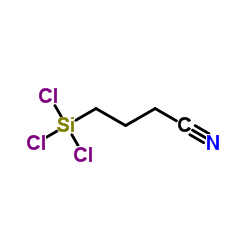
3-cyanopropyltriclorosilane structure
|
Common Name | 3-cyanopropyltriclorosilane | ||
|---|---|---|---|---|
| CAS Number | 1071-27-8 | Molecular Weight | 202.542 | |
| Density | 1.3±0.1 g/cm3 | Boiling Point | 237.5±0.0 °C at 760 mmHg | |
| Molecular Formula | C4H6Cl3NSi | Melting Point | N/A | |
| MSDS | Chinese USA | Flash Point | 92.1±22.6 °C | |
| Symbol |


GHS05, GHS07 |
Signal Word | Danger | |
| Name | 3-Cyanopropyltrichlorosilane |
|---|---|
| Synonym | More Synonyms |
| Density | 1.3±0.1 g/cm3 |
|---|---|
| Boiling Point | 237.5±0.0 °C at 760 mmHg |
| Molecular Formula | C4H6Cl3NSi |
| Molecular Weight | 202.542 |
| Flash Point | 92.1±22.6 °C |
| Exact Mass | 200.933502 |
| PSA | 23.79000 |
| LogP | 4.05 |
| Appearance of Characters | Liquid,Clear colorless |
| Vapour Pressure | 0.0±0.4 mmHg at 25°C |
| Index of Refraction | 1.467 |
| InChIKey | HMFFOEBLYHLRQN-UHFFFAOYSA-N |
| SMILES | N#CCCC[Si](Cl)(Cl)Cl |
Synonym:Butanenitrile, 4-(Trichlorosilyl)-; Silane, Trichloro(3-Cyanopropyl)- Section 2 - COMPOSITION, INFORMATION ON INGREDIENTS
Risk Phrases: 34 Section 3 - HAZARDS IDENTIFICATION EMERGENCY OVERVIEW
Causes burns.Moisture sensitive.Corrosive. Potential Health Effects Eye: Causes eye burns. May cause chemical conjunctivitis and corneal damage. Skin: Causes skin burns. May cause skin rash (in milder cases), and cold and clammy skin with cyanosis or pale color. Ingestion: May cause severe and permanent damage to the digestive tract. Causes gastrointestinal tract burns. May cause perforation of the digestive tract. May cause systemic effects. Inhalation: May cause severe irritation of the respiratory tract with sore throat, coughing, shortness of breath and delayed lung edema. Causes chemical burns to the respiratory tract. Aspiration may lead to pulmonary edema. May cause systemic effects. Chronic: Effects may be delayed. Section 4 - FIRST AID MEASURES Eyes: Get medical aid. Do NOT allow victim to rub eyes or keep eyes closed. Extensive irrigation with water is required (at least 30 minutes). Skin: Get medical aid immediately. Immediately flush skin with plenty of water for at least 15 minutes while removing contaminated clothing and shoes. Wash clothing before reuse. Destroy contaminated shoes. Ingestion: Never give anything by mouth to an unconscious person. Get medical aid. Do NOT induce vomiting. If conscious and alert, rinse mouth and drink 2-4 cupfuls of milk or water. Inhalation: Remove from exposure and move to fresh air immediately. If not breathing, give artificial respiration. If breathing is difficult, give oxygen. Get medical aid. Do NOT use mouth-to-mouth resuscitation. If breathing has ceased apply artificial respiration using oxygen and a suitable mechanical device such as a bag and a mask. Notes to Physician: Section 5 - FIRE FIGHTING MEASURES General Information: As in any fire, wear a self-contained breathing apparatus in pressure-demand, MSHA/NIOSH (approved or equivalent), and full protective gear. During a fire, irritating and highly toxic gases may be generated by thermal decomposition or combustion. Use water spray to keep fire-exposed containers cool. Vapors may be heavier than air. They can spread along the ground and collect in low or confined areas. Contact with metals may evolve flammable hydrogen gas. Containers may explode when heated. Extinguishing Media: Use agent most appropriate to extinguish fire. Do NOT get water inside containers. Cool containers with flooding quantities of water until well after fire is out. Use water spray, dry chemical, carbon dioxide, or appropriate foam. Section 6 - ACCIDENTAL RELEASE MEASURES General Information: Use proper personal protective equipment as indicated in Section 8. Spills/Leaks: Avoid runoff into storm sewers and ditches which lead to waterways. Clean up spills immediately, observing precautions in the Protective Equipment section. Absorb spill using an absorbent, non-combustible material such as earth, sand, or vermiculite. Do not use combustible materials such as sawdust. Provide ventilation. Do not get water inside containers. Section 7 - HANDLING and STORAGE Handling: Wash thoroughly after handling. Use with adequate ventilation. Avoid contact with eyes, skin, and clothing. Do not breathe dust, vapor, mist, or gas. Keep container tightly closed. Avoid ingestion and inhalation. Do not allow contact with water. Discard contaminated shoes. Keep from contact with moist air and steam. Storage: Store in a tightly closed container. Store in a cool, dry, well-ventilated area away from incompatible substances. Corrosives area. Store protected from moisture. Section 8 - EXPOSURE CONTROLS, PERSONAL PROTECTION Engineering Controls: Facilities storing or utilizing this material should be equipped with an eyewash facility and a safety shower. Use adequate ventilation to keep airborne concentrations low. Exposure Limits CAS# 1071-27-8: United Kingdom, WEL - TWA: (listed as silica, amorphous): 6 mg/m3 (inhalable dust); 2.4 mg/m3 TWA (respirable dust) United Kingdom, WEL - STEL: (listed as silica, amorphous): 18 mg/ STEL (inhalable dust); 7.2 mg/m3 STEL (respirable dust) Russia: (listed as silica, amorphous): 1 mg/m3 TWA Personal Protective Equipment Eyes: Wear appropriate protective eyeglasses or chemical safety goggles as described by OSHA's eye and face protection regulations in 29 CFR 1910.133 or European Standard EN166. Skin: Wear appropriate protective gloves to prevent skin exposure. Clothing: Wear appropriate protective clothing to prevent skin exposure. Respirators: A respiratory protection program that meets OSHA's 29 CFR 1910.134 and ANSI Z88.2 requirements or European Standard EN 149 must be followed whenever workplace conditions warrant respirator use. Section 9 - PHYSICAL AND CHEMICAL PROPERTIES Physical State: Liquid Color: clear, colorless Odor: chlorine-like pH: Not available. Vapor Pressure: Not available. Viscosity: Not available. Boiling Point: 94 deg C @ 8.00mm Hg Freezing/Melting Point: Not available. Autoignition Temperature: Not available. Flash Point: 198 deg F ( 92.22 deg C) Explosion Limits, lower: Not available. Explosion Limits, upper: Not available. Decomposition Temperature: Solubility in water: Specific Gravity/Density: 1.2800g/cm3 Molecular Formula: C4H6Cl3NSi Molecular Weight: 202.54 Section 10 - STABILITY AND REACTIVITY Chemical Stability: Stable at room temperature in closed containers under normal storage and handling conditions. Conditions to Avoid: Incompatible materials, moisture, excess heat. Incompatibilities with Other Materials: Moisture, strong acids, strong bases, strong oxidizing agents, strong reducing agents. Hazardous Decomposition Products: Hydrogen chloride, carbon monoxide, oxides of nitrogen, irritating and toxic fumes and gases, carbon dioxide, oxides of silicon. Hazardous Polymerization: Has not been reported Section 11 - TOXICOLOGICAL INFORMATION RTECS#: CAS# 1071-27-8: VV2775000 LD50/LC50: CAS# 1071-27-8: Oral, rat: LD50 = 2830 mg/kg. Carcinogenicity: Butanenitrile, 4-(Trichlorosilyl)- - Not listed by ACGIH, IARC, or NTP. Other: See actual entry in RTECS for complete information. Section 12 - ECOLOGICAL INFORMATION Section 13 - DISPOSAL CONSIDERATIONS Dispose of in a manner consistent with federal, state, and local regulations. Section 14 - TRANSPORT INFORMATION IATA Shipping Name: CHLOROSILANES, CORROSIVE, N.O.S. Hazard Class: 8 UN Number: 2987 Packing Group: II IMO Shipping Name: CHLOROSILANES, CORROSIVE, N.O.S. Hazard Class: 8 UN Number: 2987 Packing Group: II RID/ADR Shipping Name: CHLOROSILANES, CORROSIVE, N.O.S. Hazard Class: 8 UN Number: 2987 Packing group: II Section 15 - REGULATORY INFORMATION European/International Regulations European Labeling in Accordance with EC Directives Hazard Symbols: C Risk Phrases: R 34 Causes burns. Safety Phrases: S 24/25 Avoid contact with skin and eyes. S 28A After contact with skin, wash immediately with plenty of water. S 37 Wear suitable gloves. S 45 In case of accident or if you feel unwell, seek medical advice immediately (show the label where possible). WGK (Water Danger/Protection) CAS# 1071-27-8: No information available. Canada CAS# 1071-27-8 is listed on Canada's NDSL List. CAS# 1071-27-8 is not listed on Canada's Ingredient Disclosure List. US FEDERAL TSCA CAS# 1071-27-8 is listed on the TSCA inventory. SECTION 16 - ADDITIONAL INFORMATION N/A |
CHEMICAL IDENTIFICATION
HEALTH HAZARD DATAACUTE TOXICITY DATA
|
| Symbol |


GHS05, GHS07 |
|---|---|
| Signal Word | Danger |
| Hazard Statements | H314-H335 |
| Supplemental HS | Reacts violently with water. |
| Precautionary Statements | P261-P280-P305 + P351 + P338-P310 |
| Personal Protective Equipment | Faceshields;full-face respirator (US);Gloves;Goggles;multi-purpose combination respirator cartridge (US);type ABEK (EN14387) respirator filter |
| Hazard Codes | C: Corrosive; |
| Risk Phrases | R14 |
| Safety Phrases | S26-S36/37/39-S45 |
| RIDADR | UN 2987 8/PG 2 |
| WGK Germany | 2 |
| RTECS | VV2775000 |
| Packaging Group | II |
| Hazard Class | 8 |
| HS Code | 2931900090 |
|
~% 
3-cyanopropyltr... CAS#:1071-27-8 |
| Literature: Journal of the American Chemical Society, , vol. 80, p. 1737 |
|
~% 
3-cyanopropyltr... CAS#:1071-27-8 |
| Literature: Bulletin of the Chemical Society of Japan, , vol. 29, p. 784,785, 787 |
| HS Code | 2931900090 |
|---|---|
| Summary | 2931900090. other organo-inorganic compounds. VAT:17.0%. Tax rebate rate:13.0%. Supervision conditions:AB(certificate of inspection for goods inward,certificate of inspection for goods outward). MFN tariff:6.5%. General tariff:30.0% |
|
Supports for reverse-phase high-performance liquid chromatography of large proteins.
Anal. Biochem. 104(1) , 153-9, (1980)
|
|
|
Formation of an adherent polyacrylonitrile/carbon nanotubes composite film onto a polyacrylonitrile brush electrografted on copper Vast L, et al.
J. Nanosci. Nanotechnol. 7(10) , 3404-3410, (2007)
|
|
|
Behaviour of synthetic corticoids in ointment on 3-cyanopropyltrichlorosilane in high-performance thin-layer chromatography.
J. Chromatogr. A. 369(2) , 403-7, (1986)
|
| 3-CYANOPROPYLTRICHLOROSILANE |
| 4-(Trichlorosilyl)butanenitrile |
| Butanenitrile, 4-(trichlorosilyl)- |
| 3-cyanopropyltriclorosilane |
| MFCD00013832 |
| γ-cyanopropyltrichlorosilane |
| 4-trichlorosilylbutanenitrile |
| EINECS 213-990-6 |
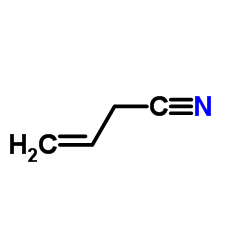
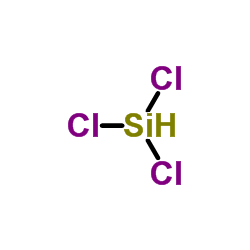

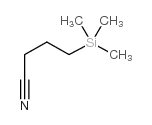 CAS#:18301-86-5
CAS#:18301-86-5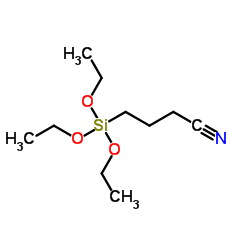 CAS#:1067-47-6
CAS#:1067-47-6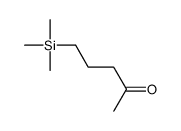 CAS#:17012-93-0
CAS#:17012-93-0 CAS#:4390-84-5
CAS#:4390-84-5